Physical Address
304 North Cardinal St.
Dorchester Center, MA 02124
† Deceased
Usually pigmented (may be amelanotic), nodular, elevated lesion with vascularity, anywhere on conjunctiva
Usually mobile, but may be fixed to sclera
Indistinct edges
More common in fair-skinned patients
Frequently develops from malignant patches of primary acquired melanosis
Metastasize to regional lymph nodes, as well as lungs, liver, brain, bone, and skin through lymphatics
Incidence increasing in the United States
Noncontributory
Mixtures of cell types, including small polyhedral cells, spindle cells, epithelioid cells, and balloon cells ( Figure 20.1 )
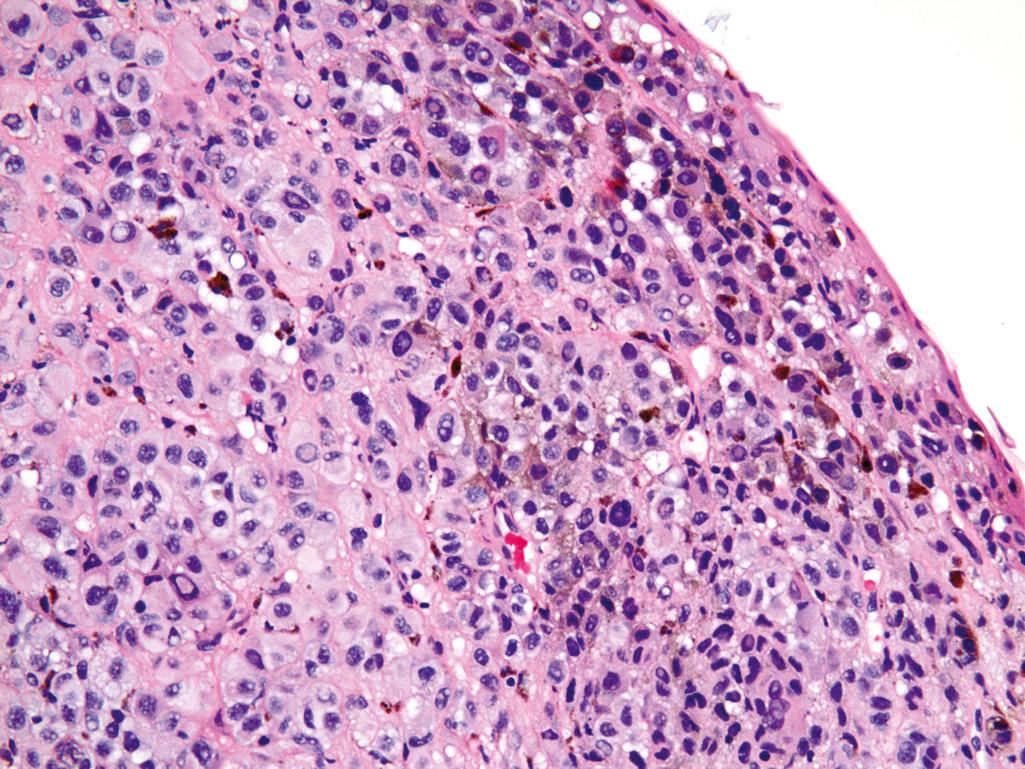
Normal polarity is lost
Invasion of overlying epithelium by tumor cells
May have epithelial cysts if arising from nevus
In more aggressive lesions, mitotic figures may be present
Often inflammation is found at the base of the lesion
S-100 protein (low specificity, high sensitivity)
HMB-45 and HMB-50 combination is less sensitive but more specific for melanomas; can be used to distinguish between benign and malignant lesions
Melan-A (MART-1) staining can be used to determine the extent of the lesion
Bcl-2 (antiapoptotic cell death protein) is a more robust and consistent marker
MIB-1 (Ki-67) used to assess proliferative index and is a marker for aggressive behavior
Tumor-suppressor phosphatase and tensin homolog deleted on chromosome ten (PTEN), and the heat-shock protein HSP-90 can also aid in differentiating conjunctival nevus from melanoma
Noncontributory
Unique to conjunctiva; analogous to melanoma in situ of skin
Primary acquired melanosis (PAM) usually lacks mitotic activity but has varying degrees of atypia
Usually congenital or acquired during youth, low malignant potential
Pigmentation and size may increase during puberty
Cysts present on histopathology approximately 50% of the time
Rarely located on palpebral conjunctiva
Metastatic from skin or uvea
Direct extension of intraocular uveal melanoma
Occurs in individuals with darker complexions
Histopathologically increased pigmentation without atypical melanocytes
Two thirds arise from preexisting PAM; one third arise de novo or from preexisting nevi
Thickness can predict prognosis: less than 15 mm, excellent prognosis; more than 15 mm, high mortality from metastases
Nonbulbar conjunctival locations (e.g., plica semilunaris/caruncle, forniceal or palpebral conjunctiva, palpebral conjunctiva) are associated with the worst prognoses
Sentinel node biopsy (preauricular and deep cervical nodes) should be considered in melanomas more than 2-mm thick as well as >10 mm in diameter
Fluorescence in situ hybridization (FISH) can be very helpful in aiding the diagnosis of difficult cases of conjunctival malignant melanoma
Local recurrence can occur in 36% to 62% of patients; frequency of lymph node metastasis is 36% to 40%
Adjuvant radiotherapy can decrease the incidence of local recurrences
Anecdotal data of successful treatment using recombinant interferon α-2b as adjuvant therapy
Breslow and Clark stain are difficult to apply
Characteristically presents as a unilateral, acquired noncystic, flat, patchy, or diffuse tan to brown pigmentation
More common in light-skinned patients
Can arise anywhere on conjunctiva, slowly enlarges over time
Freely mobile
Indistinct edges with dusty pigmentation
Average age of onset between 40 and 50 years
Potential for malignant degeneration into melanoma in approximately 12% of cases
Noncontributory
Atypical melanocytes near basal layer of epithelium ( Figure 20.2 )
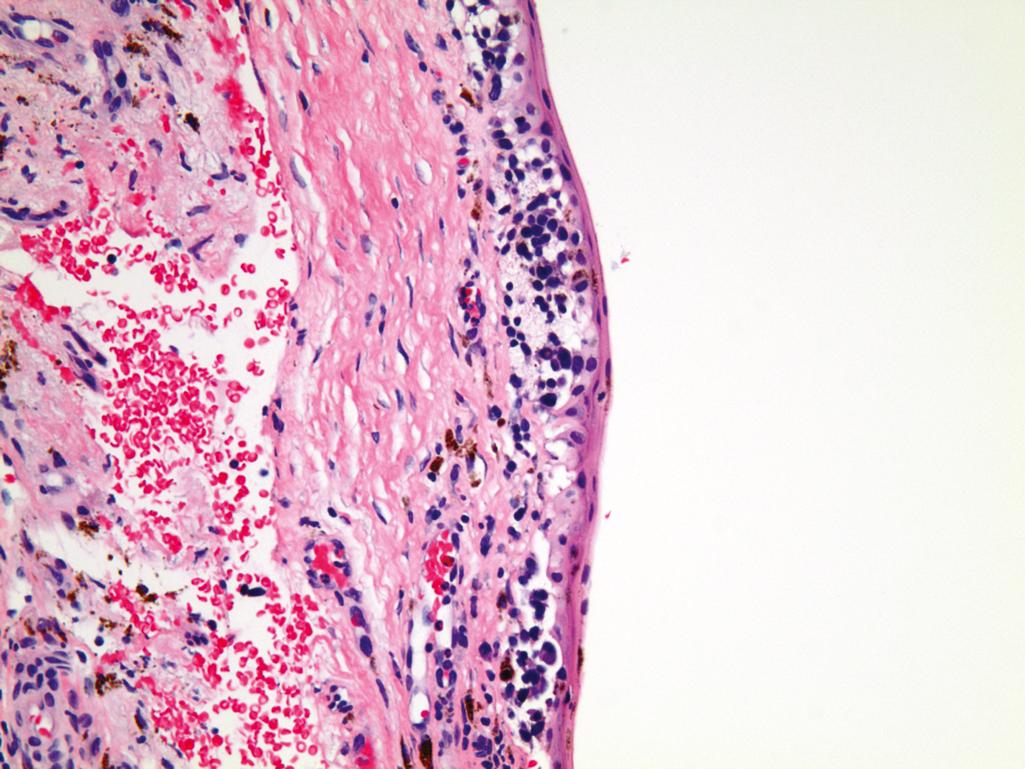
Usually divided into PAM without atypia and PAM with atypia
Malignancy potential increases with degree of cellular atypia
Ranges from mild hyperpigmentation of the epithelium (epithelial cells) with no atypical melanocytes to clusters of deep atypical melanocytes (crossover with malignant melanoma), usually arranged in pagetoid configuration
Atypical melanocytes will replace basal epithelium in the most aggressive lesions
The cells often exhibit epithelioid morphology, with large hyperchromatic nuclei, prominent nucleoli, and moderate to abundant cytoplasm
Lacks epithelial cysts of nevi of some melanomas
May be arranged in nests, which may indicate poorer prognosis
Analogous to melanoma in situ of skin
HMB-45 and HMB-50 combination immunostaining may help distinguish benign from malignant lesions
See “Malignant Melanoma of the Conjunctiva” for staining patterns
Noncontributory
Similar appearance but associated with systemic disease (e.g., Addison disease), previous radiation, pregnancy, or other conjunctival lesion (e.g., papilloma, carcinoma)
No significant risk of progression to melanoma
More atypia than PAM
Loss of normal polarity with mitotic figures
Melanocytes invade underlying stroma
Cells always arranged in nests
Benign appearance
Congenital
Adjacent epithelial cells lack pigmentation
Bilateral
Occurs in dark-skinned individuals
Benign papillomatous lesion with pigmented monolayer of basal cells
Lacks malignant features
Drug deposits (adrenochrome granules from epinephrine use)
Mascara deposits (inadvertent and intentional tattooing)
About 46% chance of malignant transformation (into melanoma) if atypical melanocytes are in the basal epithelial layer; much greater chance if melanocytes invade the epithelium in a pagetoid manner or are arranged in deep nests (75% to 90%)
Three hours or more of conjunctival involvement and caruncular, forniceal, or palpebral conjunctival locations are associated with a worse prognosis
Can consider using topical mitomycin C as an alternative treatment for PAM with atypia
Some sources advocate biopsy of all PAM lesions; others advocate biopsy only with proven growth or if obviously thick
Cellular atypia can only be determined by excisional biopsy
A surgeon performing intraocular surgery in a patient with untreated ocular surface neoplasia should exercise care, as violation of Bowman layer can lead to tumor seeding within the corneal stroma and internal structures of the eye
Cameron JD, Maltry AC. Melanocytic neoplasms of the conjunctiva. In: Mannis MJ, Holland EJ, eds. Cornea . Vol. 1. 4th ed. Philadelphia: Elsevier; 2017:434–441.
Colby K, Bhat P, Novais G, et al. Recurrent primary acquired melanosis with atypia involving a clear corneal phacoemulsification wound. Cornea . 2011;30(1):114–116.
Jakobiec FA, Folberg R, Iwamoto T. Clinicopathologic characteristics of premalignant and malignant melanocytic lesions of the conjunctiva. Ophthalmology . 1989;96:147–166.
Kurli M, Finger PT. Melanocytic conjunctival tumors. Ophthalmol Clin N Am . 2005;18:15–24.
Liesegang TJ. Pigmented conjunctival and scleral lesions. Mayo Clin Proc . 1994;69:151–161.
Shields JA, Shields CL, Mashayekhi A, et al. Primary acquired melanosis of the conjunctiva: risks for progression to melanoma in 311 eyes. Ophthalmology . 2008;115:511–519.
A conjunctival or corneal degenerative lesion that appears as an elevated yellowish-white mass overlying sclera (pinguecula) or a wing-shaped fibrovascular growth overlying sclera and cornea (pterygium)
Usually over nasal globe, occasionally temporal, usually bilateral in the interpalpebral zone
More common in middle and late life
Occurs as a result of the effects of aging, UV light exposure, and environmental insults such as dust and wind
Noncontributory
Basophilic (elastotic, actinic, or senile) degeneration of substantia propria ( Figure 20.3 )
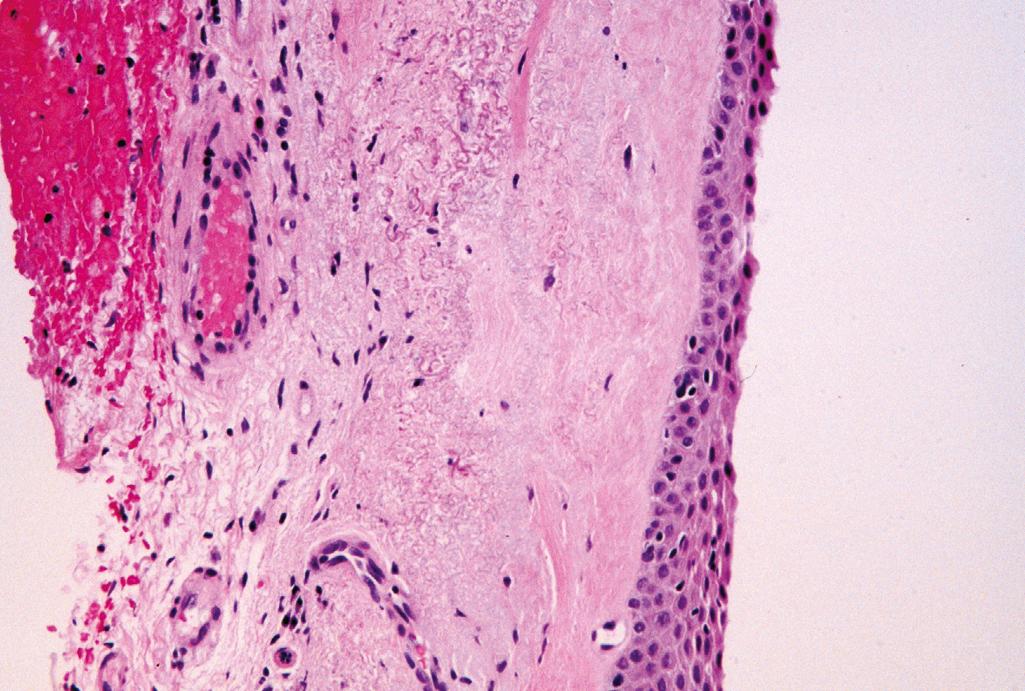
Overlying epithelium may have acanthosis, dyskeratosis, or orthokeratosis
Histopathologically similar to each other; however, pterygium invades superficial cornea and demonstrates vascularization, while pinguecula does not
Degenerated collagen stains positively with histochemical stains for elastic fibers such as the Verhoeff–Van Gieson stain
Some studies show an abnormal expression of Ki-67 and dysregulation of tumor suppressor genes such as p53 and p63
Noncontributory
Easily differentiated by lack of dysplasia in pterygium and pinguecula
Epithelial hyperplasia, nuclear hyperchromasia and pleomorphism, and excessive mitotic figures more common in ocular surface squamous neoplasia
Pseudopterygium as a result of previous penetrating injury with superficial scar formation
Surgical removal is indicated if it interferes with contact lens wear, causes significant irritation or astigmatism, or involves the visual axis
Antimetabolites such as topical mitomycin C are sometimes used to prevent recurrences
Less chance of recurrence if excision is combined with conjunctival autograft or amniotic graft
Liu T, Liu Y, Xie L, et al. Progress in the pathogenesis of pterygium. Curr Eye Res . 2013;38(12):1191–1197.
Robin JB, Schanzlin DJ, Verity SM, et al. Peripheral corneal disorders (review). Surv Ophthalmol . 1986;31:1–36.
Gelatinous, papilliform, or leukoplakic lesion, with superficial vessels
May see “corkscrew” vascular pattern and feeder vessels leading to the lesion
Usually in the interpalpebral fissure at the corneal limbus; can extend to the corneal center
Uncommonly, incompletely excised lesions can invade through corneoscleral lamellae into the anterior chamber
Thickened, well-demarcated area
Noncontributory
Hyperplasia and replacement of epithelium by atypical pleomorphic epithelial cells
Mitotic figures, loss of goblet cells, loss of cell polarity, and nuclear hyperchromasia and pleomorphism are common
Usually will stay within the epithelium (in situ, also known as conjunctival or corneal intraepithelial neoplasia [CIN]), occasionally invades deeper structures, including globe ( Figure 20.4 )
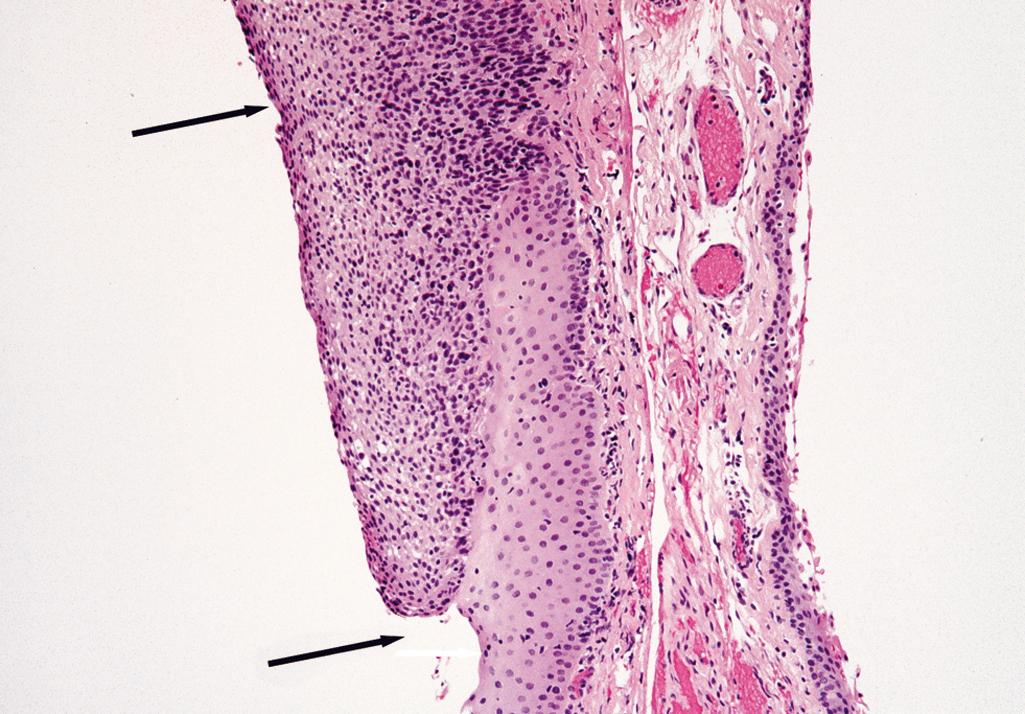
Three types of invasive conjunctival squamous cell carcinoma have been reported
Spindle cell: spindle-shaped cells are difficult to distinguish from fibroblasts; tends to invade the corneoscleral region
Mucoepidermoid carcinoma: yellow globular cystic component secondary to mucous-secreting cells within cysts; in older patients, more aggressive
Adenoid squamous carcinoma: extracellular hyaluronic acid but no intracellular mucin; aggressive form and may invade globe or orbit
Cells can gain access to blood vessels and lymphatics but rarely metastasize
Pancytokeratin and epithelial membrane antigen (EMA) staining to support surface ectodermal lineage
Noncontributory
More common in conjunctiva and eyelid than squamous cell carcinoma
Similar dysplasia but tends to have a more malignant appearance with a high proportion of cells that display intracytoplasmic vacuolization (sebaceous differentiation)
Tends to invade overlying conjunctiva in “pagetoid” pattern of spread; AR441 positivity can be helpful in detecting pagetoid spread
No dysplasia in pterygium and pinguecula
Typical finger-like projections with fibrovascular cores
Goblet cells common
Often associated with human papillomavirus (HPV)
CK17 negative squamous cells and low p53 nuclear positivity
Rare tumor of the caruncle
Cystic cavities lined by proliferating epithelium
Congenital lesion with typical clinical appearance
Histopathologically similar to dermoid cyst
Ultraviolet light exposure, aging, HPV infection, smoking, fair complexion, and immunosuppression are known risk factors
Diagnosis is usually known before excision
Neoplasia may be graded as mild, moderate, or severe depending on degree of atypia
May recur but usually stays in situ if the primary tumor was in situ
Mittal R, Rath S, Vemuganti GK. Ocular surface squamous neoplasia. Review of etio-pathogenesis and an update on clinico-pathological diagnosis. Saudi J Ophthalmol . 2013;27(3):177–186.
Pe’er J. Ocular surface squamous neoplasia. Ophthalmol Clin N Am . 2005;18:1–13.
Robin JB, Schanzlin DJ, Verity SM, et al. Peripheral corneal disorders (review). Surv Ophthalmol . 1986;31:1–36.
Shields JA, Shields CL. Premalignant and malignant lesions of the conjunctival epithelium. In: Eyelid, Conjunctival, and Orbital Tumors: An Atlas and Textbook . 3rd ed. Philadelphia: Wolters Kluwer; 2016:283–306.
Stagner AM, Jakobiec FA, Chi A, et al. Conjunctival inverted squamous papilloma: a case report with immunohistochemical analysis and review of the literature. Surv Ophthalmol . 2015;60:263–268.
Waring III GO, Roth AM, Ekins MB. Clinical and pathological descriptions of 17 cases of corneal intraepithelial neoplasia. Am J Ophthalmol . 1984;97:547–549.
More common in female patients 60 to 80 years of age
Genetic factors: Muir Torre syndrome, p53, LEF1 mutations
Represents 5% of all malignant eyelid tumors
Second most common eyelid tumor after basal cell carcinoma (more common than squamous cell carcinoma of the eyelid)
Wide range of presentations, from a small, firm nodule resembling chalazion to diffuse plaquelike thickening of the tarsus to unilateral chronic diffuse blepharitis, conjunctivitis, loss of cilia, superior limbal keratitis, or corneal pannus
Overall mortality of about 20%
May spread through direct extension into adjacent structures (orbit, nasal cavity, sinuses, intracranial cavity) or by the intraepithelial route (pagetoid invasion), lending an impression of multiple primary tumors
Originates from sebaceous glands of the eyelid and conjunctiva, usually meibomian glands of the tarsus, and from the glands of Zeis (accessory lacrimal glands in conjunctival fornix)
More common in upper eyelid
If conjunctival epithelium is involved, almost always superior tarsal and forniceal conjunctiva
Regional metastasis through lymphatics with the upper eyelid lesions spreading to the preauricular and parotid lymph nodes and the lower eyelid lesions spreading to the submandibular and cervical lymph nodes
Noncontributory
Irregular lobular masses of cells with sebaceous differentiation indicated by prominent cytoplasmic vacuolization giving foamy appearance ( Figure 20.5 )
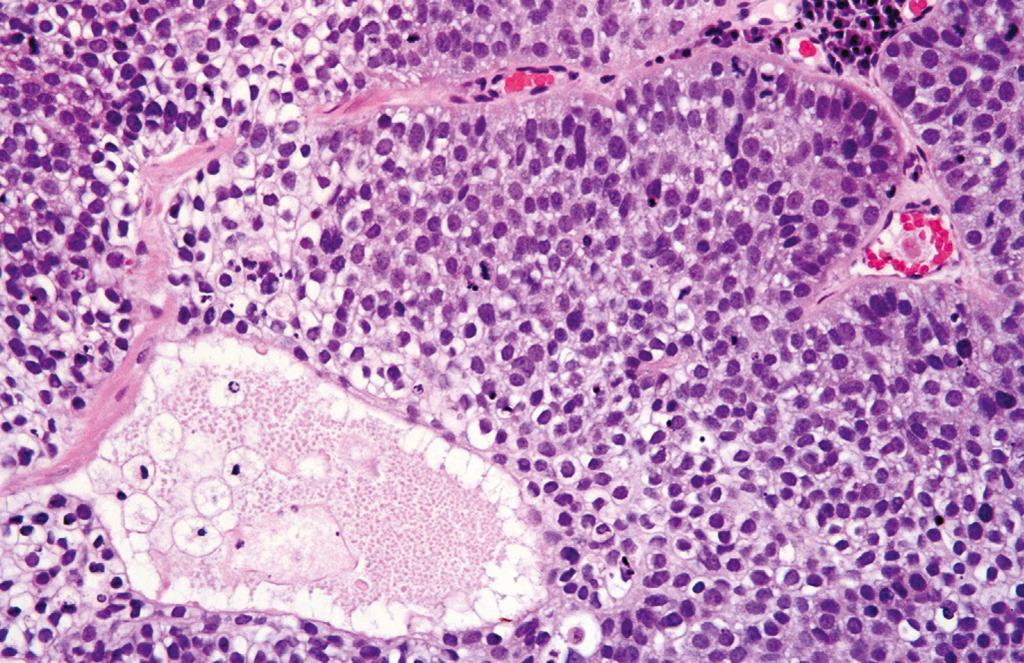
Frequent mitoses, nuclear atypia, and pleomorphism
Varies from highly differentiated to poorly differentiated (which may resemble anaplastic carcinoma)
Four histologic patterns have been identified
Lobular: neoplastic cells form well-demarcated lobules
Comedocarcinoma: large lobules with central necrotic foci
Papillary: fronds of neoplastic cells, sometimes mistaken for squamous carcinoma or squamous papilloma, although careful examination reveals sebaceous differentiation
Mixed: mixture of previous three
Small biopsies may identify strictly intraepithelial tumors, which may be manifestations of pagetoid spread; full thickness biopsy is usually advised
Oil red O stain and Sudan Black B may reveal lipid within the cytoplasm of tumor cells but is typically not necessary
BRST1 marker is positive in sebaceous carcinoma, negative in basal cell carcinoma and squamous carcinoma
AR441 positivity can be helpful in detecting pagetoid spread
EMA, CK7, and Cam 5.2 are typically expressed
Noncontributory
Lipogranulomatous inflammation on biopsy
Consider biopsy if chalazion recurs after multiple excisions
Spreads only through direct extension (unifocal)
Lacks sebaceous differentiation
Can be difficult to differentiate histopathologically
Lacks sebaceous differentiation
Hyperkeratosis, parakeratosis, keratin inclusions, and dyskeratosis
Immunohistochemistry can be useful to differentiate from sebaceous carcinoma
Sometimes associated with visceral malignancy (Muir-Torre syndrome)
Solitary benign, yellow, circumscribed nodule
Predilection for the eyebrow and eyelid
Poor prognosis is indicated by location in the upper lid, size of 10 mm or more, duration greater than 6 months, infiltrative growth pattern, and moderate to poor sebaceous differentiation
Early diagnosis and treatment with wide local excision may improve prognosis
Sometimes referred to as “the great masquerader” because it can mimic many other conditions
Can be found in younger patients who have undergone orbital irradiation (e.g., for retinoblastoma or rhabdomyosarcoma) as well as patients who are immunosuppressed
Biopsy tissue should not be placed in alcohol, which will dissolve the fat from the specimen and make the diagnosis more difficult
Kass LG, Hornblass A. Sebaceous carcinoma of the ocular adnexa. Surv Ophthalmol . 1989;33:477–490.
Rao NA, Hidayat AA, McLean IW, et al. Sebaceous gland carcinoma of the ocular adnexa: a clinicopathologic study of 104 cases with five-year follow-up data. Hum Pathol . 1982;13:113–122.
Schmitz EJ, Herwig-Carl MC, Holz FG, et al. Sebaceous gland carcinoma of the ocular adnexa – variability in clinical and histological appearance with analysis of immunohistochemical staining patterns. Graefes Arch Clin Exp Ophthalmol . 2017;255:2277–2285.
Shields JA, Saktanasate J, Lally SE, et al. Sebaceous carcinoma of the ocular region: the 2014 Professor Winifred Mao lecture. Asia Pac J Ophthalmol (Phila) . 2015;4:221–227.
Most common primary malignant intraocular tumor
Incidence of 5 to 7 per 1 million general population per year
Incidence of 20 per million per year in Caucasians older than 50 years
Unlike cutaneous melanomas, incidence rates do not vary by latitude
Lifetime risk of 1 in 2500 for whites
Median age at presentation is in the sixth decade
Less than 1% occur in patients younger than 18 years
Slightly more prevalent in men and patients with light complexions, blond hair, and blue eyes
No known hereditary component, although a few familial occurrences have been reported
Pregnancy is suggested to enhance growth of melanoma and metastases
With oculodermal melanocytosis (nevus of Ota) in a white person, there is a lifetime risk of 1 in 400
About 50% harbor mutations in GNAQ gene, which is also seen in precursor lesions
BAP1, GNA11, EIF1AX, and SF3B1 germline mutations are other driver-mutated genes associated with increased risk
Patient may be asymptomatic or may complain of blurred vision because of direct tumor involvement of macula, detachment of retina from subretinal fluid produced by tumor, vitreous hemorrhage, or massive size of tumor obscuring vision
Variably pigmented, elevated, initially flat or dome-shaped lesion noted in fundus, sometimes with orange pigment on its surface
Slow growing
Anterior (ciliary body) position may be associated with segmental cataract
Anterior (ciliary body) tumors
More difficult to visualize
Can attain a large size before clinically recognized
Associated with ≥1 dilated episcleral blood vessels, epibulbar pigmented lesion, cataractous lens, and secondary glaucoma
Can be dome shaped or have a diffuse circumferential growth pattern (ring melanoma)
High-frequency ultrasound biomicroscopy allows for better imaging of the ciliary body
Choroidal melanomas can be flat and diffuse, making clinical diagnosis more difficult
Ultrasonography demonstrates solid tumor with low to medium internal reflectivity
CT and MRI are used to evaluate extrascleral extension and differentiate intraocular hemorrhage and atypical vascular lesions from melanoma
Mushroom-shaped or dome-shaped pigmented mass in choroid or ciliary body
When these tumors arise in the choroid (as opposed to the ciliary body), they may rupture through the overlying Bruch membrane and extend into the subretinal space (giving a mushroom or collar-button shape)
Size and location are important prognostic factors (size greater than 1 cm 3 and location at the ciliary body or over the optic nerve are poor prognosticators)
Extrascleral extension can be seen, usually through scleral canals with vortex veins; this too is an important poor prognosticator
Occasionally may extend into the subconjunctival space and be mistaken for a primary conjunctival lesion
See Figure 20.6 .
Most tumors probably arise from preexisting nevi in the choroid (not retinal pigment epithelium); others arise de novo
Cell types (Callender histologic classification is most commonly used)
Spindle A
About 5% of melanomas (second least common)
Highly cohesive cells with spindle-shaped nuclei having a central stripe of chromatin (caused by nuclear fold)
Spindle cells grow as a syncytium, making cell boundaries difficult to identify
Rare mitoses
High survival rate (>90%)
Pure spindle A tumors are now considered benign and incapable of metastasis
Spindle B
Nuclei are larger and plumper than spindle A nuclei and contain prominent nucleoli rather than nuclear folds
Common type (about 35% to 40% of all melanomas)
Indistinct cell boundaries
Mitotic figures are rare, although more common than in spindle A
Often arranged in fascicular (herringbone) pattern
Moderate survival rate (about 75%)
Epithelioid
Rarest type (about 3%)
Noncohesive large cells with large nuclei and abundant cytoplasm
High degree of pleomorphism
Mitoses more common
Poor prognosis; survival of about 28%
Mixed
Most common type (about 45%)
By definition contains a mixture of epithelioid and spindle cell types
Usually spindles predominate, but the presence of epithelioid cells classifies the tumor as mixed and portends a worse prognosis
Survival rate about 40%
Necrotic
Rare
Tumor is so necrotic as to be unidentifiable in cell type
Survival approximates that of mixed-cell type
Most tumors have some necrosis
Balloon cells commonly found and may represent aging apoptotic cells
Inflammatory infiltrates commonly seen within tumor, composed mostly of T-cell lymphocytes
Macrophages (melanophages) are commonly seen scattered throughout melanomas
Degree of pigmentation varies between tumors and even within an individual tumor (varies from amelanotic to deeply pigmented)
The most recent TNM classification system for uveal melanomas is published in the 8th Edition AJCC Cancer Staging Manual and is based on the size of the primary tumor and the extent of systemic metastases
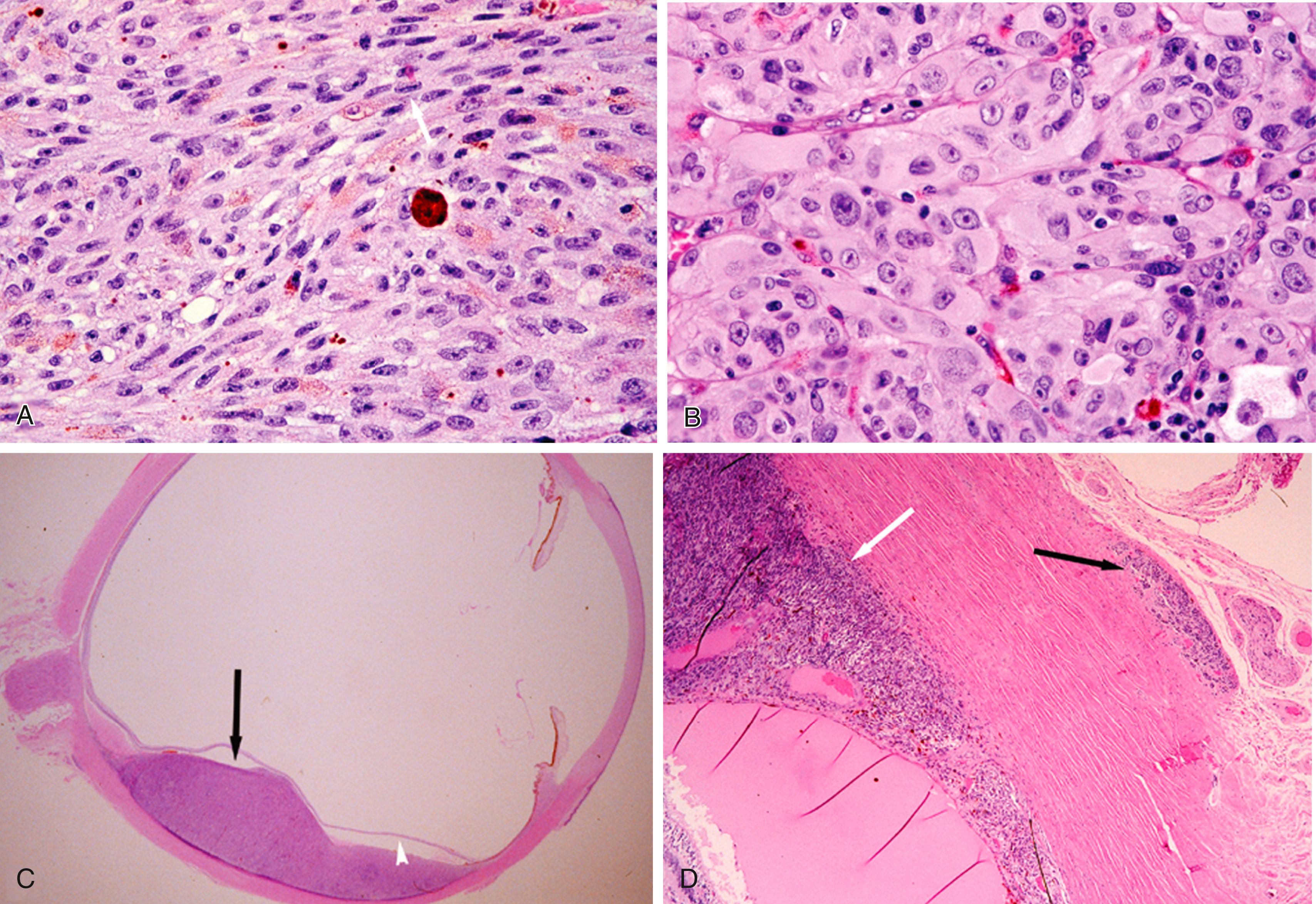
Frequently HMB-45 positive (about 50%), more specific
Commonly S-100 positive (>90%), very sensitive
Melan-A, tyrosinase, and microphthalmia transcription factor (MITF) are additional melanocytic markers
Gene expression profile (GEP) using a 12-gene expression classifier identified two classes of tumors:
Class 1 melanoma resembles melanocytes, and <5% of these metastasize
Class 1 is further divided into Class 1A (2% 5-year metastatic risk) and Class 1B (21% 5-year metastatic risk)
Class 2 melanoma resembles primitive neural or ectodermal stem cells, and 90% of these metastasize (72% 5-year metastatic risk)
Smaller than melanoma; majority are asymptomatic
Exclusively spindle cell type (usually spindle A)
Uncommonly associated with serous subretinal fluid
Never extends out of globe
Mitoses not present
Hamartoma that may occur in isolation or in association with Sturge-Weber syndrome (encephalotrigeminal angiomatosis)
Round or oval, slightly elevated orange-red lesion, usually 3 to 15 mm in diameter
Cluster of grapes appearance
Occasional leakage of fluid, similar to melanoma
Ultrasound helpful in differentiating from melanoma (high vs. medium internal reflectivity)
Histopathologically characterized by many large cavernous blood-filled spaces
Fluorescein angiography may reveal plasma–erythrocyte separation within the vascular spaces of the cavernous hemangioma, diagnostic of this lesion
Most common intraocular tumor
Usually in posterior pole, near vascular arcades
Fast growing
May be multifocal
Ultrasonography may help to differentiate from melanoma
Breast (in women) and lung (in men) are the two most common metastatic tumors to the eye
Up to 12% of all carcinomas may metastasize to choroid (based on autopsy studies)
In 20% to 45% of cases, ocular findings precede the diagnosis of the primary tumor
Histopathology varies depending on site of primary tumor
Become a Clinical Tree membership for Full access and enjoy Unlimited articles
If you are a member. Log in here